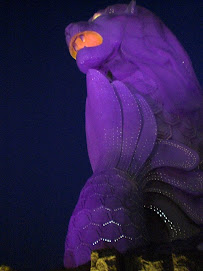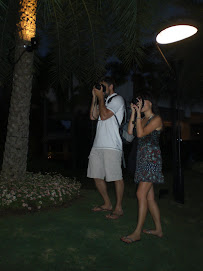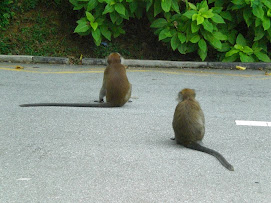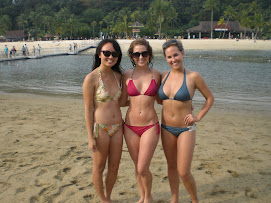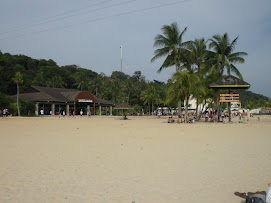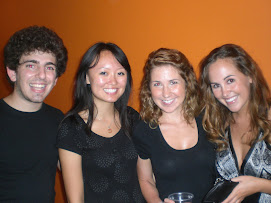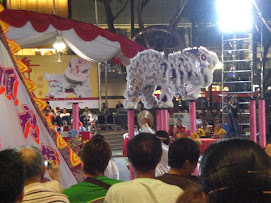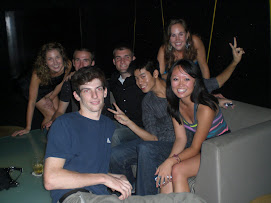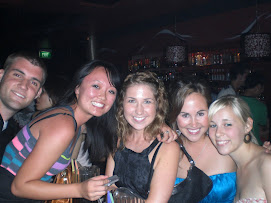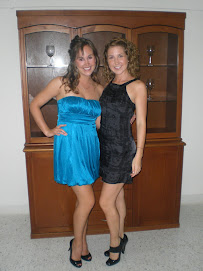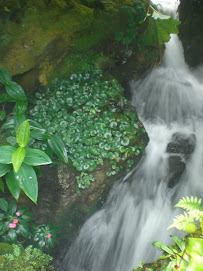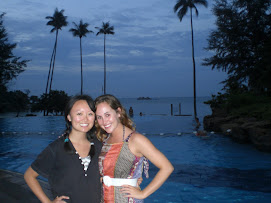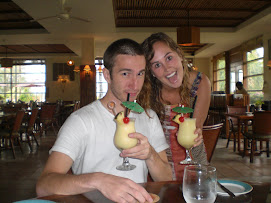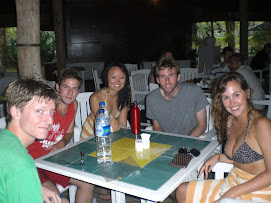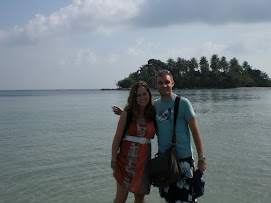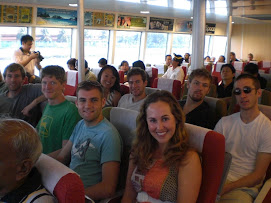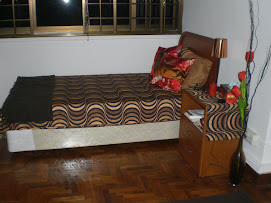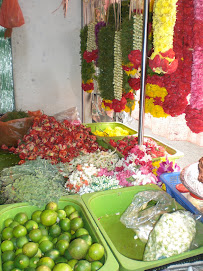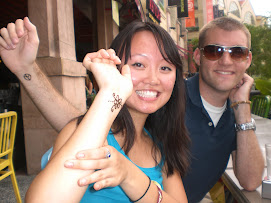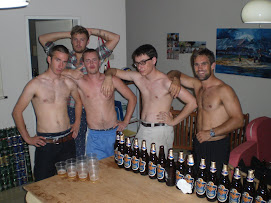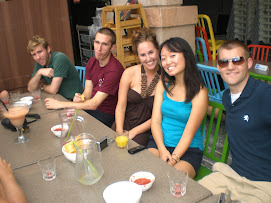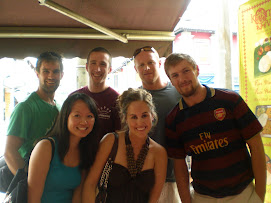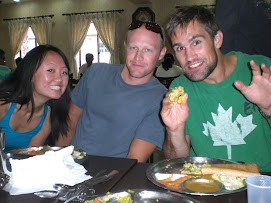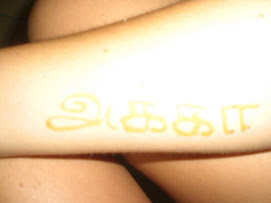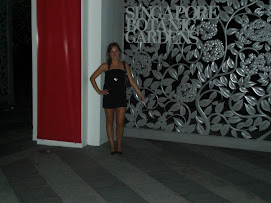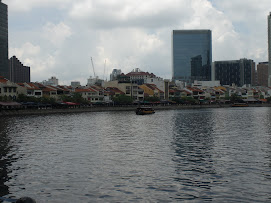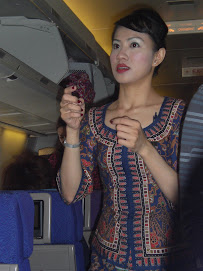Monday, November 8, 2010
Bon Voyage
“Someday soon this won’t be normal anymore,” Stephanie observed glancing up momentarily from her plate of white rice, oily vegetables, and saucy mystery meat, fork and spoon gesturing conductor-like to our surroundings.
I began to take in the environment more carefully: a stout Chinese woman shouting shrilly at her son over the clang of metal spatulas tapping metal woks; an old, glassy-eyed uncle without a shirt or shoes sipping what must have been his fifth Tiger of the early evening; a timid, petite girl stealing shy glimpses our way while chopping hot red peppers to make the kind of sauce that clears your sinuses when you look at it; a beer girl, just passed her prime, wandering between crowded, yellowing plastic tables and chairs. “When did all this become normal?” I wondered, racking my brain for the exact moment when I walked passed one of the outdoor food courts, which often smell of fish insides and curry spices, and didn’t bat an eye.
But here I am, 14 months beyond my first Hawker center experience when I sat poking balls of white fluff with an awkwardly held chopstick in an effort to reveal whether the inside stuffing looked edible or not (I have since discovered that these snow-ball like pastries filled with anything from pork to lotus to red bean are called bao). And I haven’t once thought about the pungent smells of the seafood stall, the kind of health code violations that my dad would probably spot in the kitchen of the stall from which I ordered my mixed vegetable rice, or the sweat trickling down my lower back, the heat of the night amplified by the cooking fires and the close proximity of people. I then look down at my own plate and realize, in true Singaporean fashion, I’ve subconsciously grabbed my spoon with my right hand and am using my fork to scoop the food onto the spoon before eating off the spoon only. It is considered impolite to put the fork in your mouth.
All this, the thoughts, the sensations, the realizations, happens in a fleeting moment. I look at Steph, shake my head, roll my eyes, and smile an understanding smile that slowly fades as we lean back in our chairs lost in our own thoughts. “When did all this become normal?”
It is hard to believe at this moment that those people and things which have become such a normal part of my everyday life in Singapore will soon again be exotic, strange, a memory. It is even more difficult to believe that that which used to be normal in my life in America will probably, at first, seem exotic, strange, a memory re-incarnated.
So, I guess what I am trying to say as I prepare to return to America is: please bear with me when I walk into Super WalMart and nearly burst into tears, because everything I need is all in one location. Please bear with me when I have a craving for Indian food and scoff at the Mexican I’ve been craving all year in Singapore, because Little India has been just a train ride away. Please bear with me when I turn into a lane of oncoming traffic, because I’ve been riding on the other side of the rode. Please bear with me when I ask you to explain once again why we can’t go to the beach in January, because I have been living a three-hour plane ride from Bali. Please bear with me when I walk snottily passed every Chinese restaurant in the food court, because it is not real Chinese food. Please bear with me when I say a phrase that sounds like English but you cannot really fully understand what I mean, because I have been speaking primarily to Singaporean adolescents all year. Please bear with me when I complain about how cold I am, because I have been living in a sauna. Please bear with me when I speak of the foods, cultures, histories and geographies of Southeast Asian countries as if everyone should know and relate to what I’m talking about, because I’ve learned a lot this year and it is all incredibly interesting to me. Please bare with me as I readjust to life in America, because they say reverse culture shock is often worse than its predecessor.
But, to lighten the culture shock blow a bit, for the next five weeks I will be on a vacation adventure which should leave me, while quite happy, exhausted and ready to return home for Christmas. As I make my way across Myanmar, India, Bangkok, Laos and Vietnam, I look forward to the final surprises Asia has left in store for me.
For now, I am packing my life into a backpack and three suitcases and enjoying my last views of the Singapore skyline, my last picnics in the botanical gardens, my last farewells with my students and friends ,and my last Hawker Center meals. You’ve been good to me…bon voyage Singapore!
TIA,
Rachel
I began to take in the environment more carefully: a stout Chinese woman shouting shrilly at her son over the clang of metal spatulas tapping metal woks; an old, glassy-eyed uncle without a shirt or shoes sipping what must have been his fifth Tiger of the early evening; a timid, petite girl stealing shy glimpses our way while chopping hot red peppers to make the kind of sauce that clears your sinuses when you look at it; a beer girl, just passed her prime, wandering between crowded, yellowing plastic tables and chairs. “When did all this become normal?” I wondered, racking my brain for the exact moment when I walked passed one of the outdoor food courts, which often smell of fish insides and curry spices, and didn’t bat an eye.
But here I am, 14 months beyond my first Hawker center experience when I sat poking balls of white fluff with an awkwardly held chopstick in an effort to reveal whether the inside stuffing looked edible or not (I have since discovered that these snow-ball like pastries filled with anything from pork to lotus to red bean are called bao). And I haven’t once thought about the pungent smells of the seafood stall, the kind of health code violations that my dad would probably spot in the kitchen of the stall from which I ordered my mixed vegetable rice, or the sweat trickling down my lower back, the heat of the night amplified by the cooking fires and the close proximity of people. I then look down at my own plate and realize, in true Singaporean fashion, I’ve subconsciously grabbed my spoon with my right hand and am using my fork to scoop the food onto the spoon before eating off the spoon only. It is considered impolite to put the fork in your mouth.
All this, the thoughts, the sensations, the realizations, happens in a fleeting moment. I look at Steph, shake my head, roll my eyes, and smile an understanding smile that slowly fades as we lean back in our chairs lost in our own thoughts. “When did all this become normal?”
It is hard to believe at this moment that those people and things which have become such a normal part of my everyday life in Singapore will soon again be exotic, strange, a memory. It is even more difficult to believe that that which used to be normal in my life in America will probably, at first, seem exotic, strange, a memory re-incarnated.
So, I guess what I am trying to say as I prepare to return to America is: please bear with me when I walk into Super WalMart and nearly burst into tears, because everything I need is all in one location. Please bear with me when I have a craving for Indian food and scoff at the Mexican I’ve been craving all year in Singapore, because Little India has been just a train ride away. Please bear with me when I turn into a lane of oncoming traffic, because I’ve been riding on the other side of the rode. Please bear with me when I ask you to explain once again why we can’t go to the beach in January, because I have been living a three-hour plane ride from Bali. Please bear with me when I walk snottily passed every Chinese restaurant in the food court, because it is not real Chinese food. Please bear with me when I say a phrase that sounds like English but you cannot really fully understand what I mean, because I have been speaking primarily to Singaporean adolescents all year. Please bear with me when I complain about how cold I am, because I have been living in a sauna. Please bear with me when I speak of the foods, cultures, histories and geographies of Southeast Asian countries as if everyone should know and relate to what I’m talking about, because I’ve learned a lot this year and it is all incredibly interesting to me. Please bare with me as I readjust to life in America, because they say reverse culture shock is often worse than its predecessor.
But, to lighten the culture shock blow a bit, for the next five weeks I will be on a vacation adventure which should leave me, while quite happy, exhausted and ready to return home for Christmas. As I make my way across Myanmar, India, Bangkok, Laos and Vietnam, I look forward to the final surprises Asia has left in store for me.
For now, I am packing my life into a backpack and three suitcases and enjoying my last views of the Singapore skyline, my last picnics in the botanical gardens, my last farewells with my students and friends ,and my last Hawker Center meals. You’ve been good to me…bon voyage Singapore!
TIA,
Rachel
Wednesday, October 20, 2010
Longing for a cowboy and a mahogany horse
A lone cowboy on a mahogany horse gallops at full speed across a pure blue and golden-wheat colored canvas. I can feel the velvet Earth under my bare feet. The world smells of dust and an impending rain. I have been here many times before.
It is a summer morning in a South Dakota prairie town. It is a crisp fall afternoon enveloping the Wyoming grasslands in a gentle embrace. It is an endless drive home across the Nebraska pastures.
In reality, I am staring at, well who am I kidding, I am practically hypnotized by a picture in the October 2010 issue of "National Geographic" magazine taken in West Texas in 1974. I have never actually been there, yet I have many times.
In the article, entitled “Under the Big Sky” the author describes a morning in Wyoming "the first light on high mountain meadows, the wisps of clouds within my reach,” and I can see the place.
He goes on to say, “I suppose we all feel more restricted today. There seem to be gates in our lives that we never get open. But if we’re lucky, we find a special place to us. Even though it may change with time, if we love it deeply enough, there is a part of it within us to the end.” To me, this is the American Midwest.
It is probably inevitable that as my time in Asia dwindles, I begin to dream of frost covered winter mornings, proud, graceful deer hopping metronomic-ally over wind-torn fences, and oceans of brown, green, and tan that wave on seemingly endlessly into nothingness until they kiss the sky. Yet, I also like to think that when I look back on my time in Singapore, I will find that the breathtakingly powerful tropical thunderstorms, the hiss of cool oil on hot woks, the palm-tree framed balmy sunsets, and the anxious, rhythmic dance of the public transportation system have also occupied such a special place in my heart that they have become a part of me as well.
So, of course, in between marking in the last few weeks, I have set out to make the most of these now limited days.
Steph and I spent one night on a legitimate night safari (not the one at the zoo…although I wouldn’t exactly call that night safari illegitimate either considering the fire dancers) with a camera crew on a special expedition inside Bukit Timah nature reserve to spot the creatures who lurk and crawl when human activity ceases after dark. Among our finds: snakes, spiders, scorpions, and bugs I never want to see again. Our lucky, and thoroughly undeserved, participation in the tour was due to a previously mentioned 15-minutes-of-fame experience when Steph and I were photographed at another nature reserve and subsequently published in a photographer/author/dentist-by-day’s book. Through this connection, we were given the opportunity to accompany this group of photographers and nature researchers into the “wild.”
I also spent one day as the subject of a photo shoot, though not one for a nature magazine this time, when my friend Will and his faithful assistant, Stephanie, helped me to take headshots and body shots: think senior photos but with far less pressure due to the lack of the wallet-sized versions, which may come back to haunt you for the rest of your life in the form high school reunions.
I have spent some quality time bonding with my colleagues and my new roommate cum colleague, Victoria, eating out for Mexican and, as a neighbor of the cuisine’s home country, subsequently ordering for everyone; enjoying an a cappella concert inclusive of a “Grease” mix during which I could not help but picture my dad as a little boy dancing as Danny on the couch…I mean hood of a chick-magnet car…; celebrating the end of Hari Raya, which marks the end of the fasting month for my Muslim friends; and whipping up a multi-cultural salad day feast for our English-department hosted lunch at school.
In keeping with the variety-show that is my life, Sarah, Steph, Kurt, and I even went to a Sunday morning brunch at an equestrian training and horse stabling turf club which felt more like a ranch in Pennsylvania than a restaurant in tropical Singapore. And, Steph, Victoria, Yui Yun, and I rode the train, which is due to officially close in June 2011, ladies-who-lunch-style over the boarder to Malaysia for pedicures and shopping one Saturday afternoon.
Now that my marking is done, I am busying myself with a mini-musical on which I have been working with one of my classes this semester as well as trying not to think about having to say goodbye to them. This ordeal is made all the more challenging when they throw me a “surprise” (not overly uncharacteristically, one of them accidently told me) goodbye party complete with a Barbie-doll pink cake, a frosting fight, and a rousing rendition of “We Love You Miss Rachel.”
For now, I have resolved to live in every moment, to love even my final highs and lows, and to put away the National Geographic picture at which I have been so longingly gazing for the last couple hours.
Cheers to my last three weeks in Singapore,
Rachel
It is a summer morning in a South Dakota prairie town. It is a crisp fall afternoon enveloping the Wyoming grasslands in a gentle embrace. It is an endless drive home across the Nebraska pastures.
In reality, I am staring at, well who am I kidding, I am practically hypnotized by a picture in the October 2010 issue of "National Geographic" magazine taken in West Texas in 1974. I have never actually been there, yet I have many times.
In the article, entitled “Under the Big Sky” the author describes a morning in Wyoming "the first light on high mountain meadows, the wisps of clouds within my reach,” and I can see the place.
He goes on to say, “I suppose we all feel more restricted today. There seem to be gates in our lives that we never get open. But if we’re lucky, we find a special place to us. Even though it may change with time, if we love it deeply enough, there is a part of it within us to the end.” To me, this is the American Midwest.
It is probably inevitable that as my time in Asia dwindles, I begin to dream of frost covered winter mornings, proud, graceful deer hopping metronomic-ally over wind-torn fences, and oceans of brown, green, and tan that wave on seemingly endlessly into nothingness until they kiss the sky. Yet, I also like to think that when I look back on my time in Singapore, I will find that the breathtakingly powerful tropical thunderstorms, the hiss of cool oil on hot woks, the palm-tree framed balmy sunsets, and the anxious, rhythmic dance of the public transportation system have also occupied such a special place in my heart that they have become a part of me as well.
So, of course, in between marking in the last few weeks, I have set out to make the most of these now limited days.
Steph and I spent one night on a legitimate night safari (not the one at the zoo…although I wouldn’t exactly call that night safari illegitimate either considering the fire dancers) with a camera crew on a special expedition inside Bukit Timah nature reserve to spot the creatures who lurk and crawl when human activity ceases after dark. Among our finds: snakes, spiders, scorpions, and bugs I never want to see again. Our lucky, and thoroughly undeserved, participation in the tour was due to a previously mentioned 15-minutes-of-fame experience when Steph and I were photographed at another nature reserve and subsequently published in a photographer/author/dentist-by-day’s book. Through this connection, we were given the opportunity to accompany this group of photographers and nature researchers into the “wild.”
I also spent one day as the subject of a photo shoot, though not one for a nature magazine this time, when my friend Will and his faithful assistant, Stephanie, helped me to take headshots and body shots: think senior photos but with far less pressure due to the lack of the wallet-sized versions, which may come back to haunt you for the rest of your life in the form high school reunions.
I have spent some quality time bonding with my colleagues and my new roommate cum colleague, Victoria, eating out for Mexican and, as a neighbor of the cuisine’s home country, subsequently ordering for everyone; enjoying an a cappella concert inclusive of a “Grease” mix during which I could not help but picture my dad as a little boy dancing as Danny on the couch…I mean hood of a chick-magnet car…; celebrating the end of Hari Raya, which marks the end of the fasting month for my Muslim friends; and whipping up a multi-cultural salad day feast for our English-department hosted lunch at school.
In keeping with the variety-show that is my life, Sarah, Steph, Kurt, and I even went to a Sunday morning brunch at an equestrian training and horse stabling turf club which felt more like a ranch in Pennsylvania than a restaurant in tropical Singapore. And, Steph, Victoria, Yui Yun, and I rode the train, which is due to officially close in June 2011, ladies-who-lunch-style over the boarder to Malaysia for pedicures and shopping one Saturday afternoon.
Now that my marking is done, I am busying myself with a mini-musical on which I have been working with one of my classes this semester as well as trying not to think about having to say goodbye to them. This ordeal is made all the more challenging when they throw me a “surprise” (not overly uncharacteristically, one of them accidently told me) goodbye party complete with a Barbie-doll pink cake, a frosting fight, and a rousing rendition of “We Love You Miss Rachel.”
For now, I have resolved to live in every moment, to love even my final highs and lows, and to put away the National Geographic picture at which I have been so longingly gazing for the last couple hours.
Cheers to my last three weeks in Singapore,
Rachel
Tuesday, September 21, 2010
My life on a bus
Before the countdown: It is 8:30 a.m. at the airport in Jakarta, Indonesia. I arrive a bit blurry-eyed due to my 5:30 a.m. wake-up call, but I have a naïve spring in my step none-the-less.
Hour one: I have taken a $.50 bus ride to the train station in the city center. I spent most of the ride marveling at the overlapping free-ways, sparkling high rise buildings, fancy SUVs, international-class hotels and restaurants, and the man next to me who is typing on three black-berries simultaneously that make this city of 10 million feel more like New York than Indonesia.
Hour one point two-five: It is September 8th. It is 9:45 a.m. The next available train ticket to Yogyakarta, the city which is to be my final destination, is for September 10th at 8 p.m. Plan B.
Hour one point five: I am arguing with a man about whether a cab to the bus station should cost 70,000 rupiah or 50,000 rupiah. I realize I am actually arguing with a man about whether a cab to the bus station should cost $7 or $5. Screw it. I’ll settle on six and a half.
Hour two: I arrive at the bus station, sweaty, breathless, and with much less spring in my step, after risking my life to cross a major bus-filled highway on foot. I paid the man 65,000 rupiah to drive me here and he “cannot pull into the station, cabs not allowed.” I see a cab stop in front of the station. The couple that gets out is neither sweaty nor breathless. I should have paid him 70,000.
Hour two point five: I have managed to find the one person who speaks English in the crowd of thousands lining up to get on tens of buses. She leads me to a bus that she promises will take me to Yogyakarta. The bus is empty. She leaves. It is 11 a.m.
Hour two point seven-five: It is 11:15. I am alone on a bus, which I think is going to Yogyakarta, but I am not really sure. I have no ticket. There is no air-conditioning. I’m not sure if the bus even runs. I think I better find the English-speaking woman.
Hour four: The woman has sold me a ticket. The bus leaves at 2 p.m. In the meantime, I have eaten a box of chocolate-covered strawberry filled cookies and am working on my second course…something called cheese cookies and what looks like a juice box of tea. A very small, very happy graying Indonesian man is telling me that he is an English teacher at a local school and would like to practice conversation. We are standing amidst the exhaust fumes of thirty buses and are surrounded by crowds of sweaty people straining to hear bus numbers which are simply shouted out over the din by young boys in blue button-ups. No one except my bus mistress, my enthusiastic English-teaching friend, and I speak English. I am quite amused.
Hour five: It is 1:30 in the afternoon. I have boarded the bus. Everyone else, including my somewhat large and hairy seatmate, has boarded also. It takes me a good ten minutes to shove my backpack under my seat. I have the window seat. My seatmate doesn’t move when I do this. I finally sit down and heave a sigh of relief. Everyone on the bus is staring at me. I stare back. So do they. So, this is what it feels like to be in a fishbowl.
Hour five and one quarter: A woman's seat is broken. It leans back too far. One of our bus drivers grabs a metal pole from who know where and shoves is through the arm rests at the back of the seat. Problem solved.
Hour five point five: We should be leaving soon. It is 2 p.m. The mother with her seven-year-old child sitting across from me has managed to mime that she likes my nose because it is pointy. She has also “told” me that her son’s is no good. It is too flat. Now everyone is staring at my pointy nose. Some even lean in for a closer look. Thank you Knutson genes.
Hour five and three quarters: I am marking some papers I have brought along with to kill the time. I have a rotating audience looking over my shoulder. They can’t possibly be interested in my student’s English papers, so I blame my pointy nose. People occasionally board the bus to sell things like fresh duck eggs, rice meals, mixed nuts, and sunglasses. One man trades me a bottle of water for a July issue of Time. Now, if he ever sees another person who speaks English, he will have something to sell to them.
Hour six point five: The bus is leaving. We are an hour late. We should arrive in Yogya in twelve hours.
Hour eight and a half: It is 5 p.m. We might still be in the suburbs of Jakarta. I have finished two issues of Time cover to cover…including that small print at the bottom of all the advertisements. We are maybe driving twenty miles per hour. I remember a New York Times article that I casually read last week.
“During the last days of Ramadan, the Islamic month of fasting, tens of millions of Indonesians leave the country’s cities to return to their villages by motorcycle, train, bus and boat. The mass homecoming is both a decidedly Indonesian interpretation of the Muslim holiday and one of the world’s great movements of people. On a road network whose capacity is strained at the best of times, travellers brave enormous jams, exhaustion and bandits to make it back home.”
I am literally a part of the second largest temporary migration of people in the world…thirty million plus one. At least the air conditioning works.
Hour eight point seven-five: The air conditioning has stopped working.
Hour nine point five: The sun is setting. The villages that are passing slowly by become a swirl of sunset oranges and soft yellows. The people are smiling and celebrating in their roadside stalls. They are beautiful. I watch them.
Hour eleven: I am not really sure if I have been sleeping or awake. Probably both.
Hour twelve: We stop for dinner. I avoid the rice and vegetable and chicken mixtures that are swarming with flies. It might be safer to eat packaged food. Besides, I want to avoid that bus bathroom as much as possible. Dried bananas, cashews, and puff pastry it is.
Hour thirteen: I don’t know if you can imagine what it feels like to be on hour seven in a traffic jam that stretches across an entire country, on a bus that is moving twenty miles per hour, with people you can’t even talk to because you don’t speak the same language, but, if you can’t, don’t try it.
Hour fifteen: The bus broke down. We are in the middle of a highway in a massive traffic jam and the bus broke down. We have been in a bus for eight and a half hours and the bus has just broken down. If I was less calm in the face of challenges, I might scream. Instead, I think I’ll hyperventilate.
Hour fifteen plus ten minutes: Our bus driver has calmly reignited the engine. Shadey at best. I have put away my paper bag. The air conditioning is working again.
Hour seventeen: It is 1:30 a.m. I have begun to make up stories about the flickers of light from the oncoming cars that reflect off the bus windows. They are about fireflies. This might be what it feels like to go crazy.
Hour eighteen and a half: The hairy man sitting next to me has been sleeping on my shoulder for the last hour. My arm is asleep. I don’t want to disturb him though, so I let my arm become all tingly, and I make up a story about it.
Hour nineteen: Something more exciting to distract me than my imagination: people have begun to pull off to the side of the road and light fireworks. I am being given my own private show. Little sparks of purple, blue, and red briefly illuminate the night sky. As a bonus, the bus picks up speed. I fall asleep with visions of fireworks dancing in my head and behind my eyelids.
Hour twenty-one point five: I open my eyes to find a smoking volcano appearing in the first purple light of day. We are navigating winding roads on the slopes of a jungle mountain, and the foliage has overgrown the road so that I can actually see the dew drops sliding off the pink and salmon petals of the tropical flowers in the canopy above. The rice patties in the distance are emerald green.
Hour twenty-two point five: The bus driver just told me we are about eight hours from Yogya. I have been on a bus for 16 hours.
Hour twenty three: My butt is completely asleep.
Hour twenty three point seven-five: I am doing yoga in the aisle. If my bus-mates didn’t think I was crazy before, they do now.
Hours twenty four to twenty eight: I finish my marking. I stretch a little. I make faces at the kids in buses we pass and they make faces back at me. I finish my remaining two Time magazines, and I use the Southeast Asia travel guide to plan my entire November/December holiday. We pass through endless plains of brilliant green rice patties. I play games on my phone with the kid whose mom thinks his nose is too flat. I let my seatmate sleep on my shoulder…again. Time passes.
Hour twenty eight and one quarter: People are restless. We have been on a bus for twenty one hours and forty five minutes. The traffic is ridiculous. I feel a bit like I am at the Sturgis motorcycle rally with fewer helmets, more rice fields, and a greater person to bike ratio. I do another round of yoga. People request pictures. I have a photo shoot with every family on the bus. My pointy nose is sure to make mantelpieces all over Java.
Hour twenty nine point five: It is 2 p.m. We are in the suburbs of Yogya. I can tell by the signs. We are starting to drop people off on various corners.
Hour thirty and a half: I arrive at the bus station. I have been on a bus for 24 hours. I have been attempting to get to Yogya for more than that. Nothing else matters now, though, because I am here, I am safe, I was a part of the second largest temporary land migration on the planet, and I had the experience of a lifetime.
Of course, the reminder of my trip was not nearly as much of a physical or emotional roller coaster. In fact, it was wonderful. But “pleasant” does not make for an interesting story. So here, I will simply relay the highlights of the rest of my trip.
Stephanie met me at our adorable bed and breakfast that evening (she had chosen to fly because she got out of school a day later…no comment). We spent our first full day in Yogya together walking along an old lava flow on Gunung Merapi, the most active volcano in Indonesia, hiking to caves made during the Japanese occupation, exploring the batik markets, and savoring some traditional Javanese beer and cuisine.
The second night was spent in a hostel on a rice patty where we were lulled to sleep underneath our mosquito net by the sound of croaking bull frogs just outside our windows. The highlight of the trip was the sunrise atop Borobudur temple where we watched the sun slowly unveil the volcano in the distance. Borobudur is both a Buddhist temple and a place for pilgrimage. According to Wikipedia, "the journey for pilgrims begins at the base of the monument and follows a path circulating the monument while ascending to the top through the three levels of Buddhist cosmology, namely Kāmadhātu (the world of desire), Rupadhatu (the world of forms) and Arupadhatu (the world of formlessness). During the journey the monument guides the pilgrims through a system of stairways and corridors with 1,460 narrative relief panels on the wall."
Our second afternoon was spent exploring Yogya on foot before we took the night train (a form of transport that actually only took eight hours due to the lack of traffic) back to Jakarta.
On Sunday, we immersed ourselves in the Hari Raya celebrations in Jakarta taking in street performances, enjoying cotton candy in the National Monument’s park, and watching locals “sort of” re-create the old-Dutch feel in the Dutch quarter by riding bicycles while wearing floppy hats within a perimeter. Our last moments in Jakarta were spent sipping coffee and eating gourmet Javanese food in a secret garden-esque restaurant.
Now that the September holidays are over, I have officially begun my final term of teaching in Singapore. For the next several weeks I will be lesson planning, marking final exams, finalizing forms, preparing for my end-of-contract travels, applying for graduate programs, and generally figuring out my future.
I have officially begun tackling my Singapore bucket list. I’ll keep you posted.
xoxo,
Rachel
http://picasaweb.google.com/rachelknutson.knutson8/InIndo#
http://picasaweb.google.com/rachelknutson.knutson8/SeptemberSurprisesAndSomeInAugustToo#
Hour one: I have taken a $.50 bus ride to the train station in the city center. I spent most of the ride marveling at the overlapping free-ways, sparkling high rise buildings, fancy SUVs, international-class hotels and restaurants, and the man next to me who is typing on three black-berries simultaneously that make this city of 10 million feel more like New York than Indonesia.
Hour one point two-five: It is September 8th. It is 9:45 a.m. The next available train ticket to Yogyakarta, the city which is to be my final destination, is for September 10th at 8 p.m. Plan B.
Hour one point five: I am arguing with a man about whether a cab to the bus station should cost 70,000 rupiah or 50,000 rupiah. I realize I am actually arguing with a man about whether a cab to the bus station should cost $7 or $5. Screw it. I’ll settle on six and a half.
Hour two: I arrive at the bus station, sweaty, breathless, and with much less spring in my step, after risking my life to cross a major bus-filled highway on foot. I paid the man 65,000 rupiah to drive me here and he “cannot pull into the station, cabs not allowed.” I see a cab stop in front of the station. The couple that gets out is neither sweaty nor breathless. I should have paid him 70,000.
Hour two point five: I have managed to find the one person who speaks English in the crowd of thousands lining up to get on tens of buses. She leads me to a bus that she promises will take me to Yogyakarta. The bus is empty. She leaves. It is 11 a.m.
Hour two point seven-five: It is 11:15. I am alone on a bus, which I think is going to Yogyakarta, but I am not really sure. I have no ticket. There is no air-conditioning. I’m not sure if the bus even runs. I think I better find the English-speaking woman.
Hour four: The woman has sold me a ticket. The bus leaves at 2 p.m. In the meantime, I have eaten a box of chocolate-covered strawberry filled cookies and am working on my second course…something called cheese cookies and what looks like a juice box of tea. A very small, very happy graying Indonesian man is telling me that he is an English teacher at a local school and would like to practice conversation. We are standing amidst the exhaust fumes of thirty buses and are surrounded by crowds of sweaty people straining to hear bus numbers which are simply shouted out over the din by young boys in blue button-ups. No one except my bus mistress, my enthusiastic English-teaching friend, and I speak English. I am quite amused.
Hour five: It is 1:30 in the afternoon. I have boarded the bus. Everyone else, including my somewhat large and hairy seatmate, has boarded also. It takes me a good ten minutes to shove my backpack under my seat. I have the window seat. My seatmate doesn’t move when I do this. I finally sit down and heave a sigh of relief. Everyone on the bus is staring at me. I stare back. So do they. So, this is what it feels like to be in a fishbowl.
Hour five and one quarter: A woman's seat is broken. It leans back too far. One of our bus drivers grabs a metal pole from who know where and shoves is through the arm rests at the back of the seat. Problem solved.
Hour five point five: We should be leaving soon. It is 2 p.m. The mother with her seven-year-old child sitting across from me has managed to mime that she likes my nose because it is pointy. She has also “told” me that her son’s is no good. It is too flat. Now everyone is staring at my pointy nose. Some even lean in for a closer look. Thank you Knutson genes.
Hour five and three quarters: I am marking some papers I have brought along with to kill the time. I have a rotating audience looking over my shoulder. They can’t possibly be interested in my student’s English papers, so I blame my pointy nose. People occasionally board the bus to sell things like fresh duck eggs, rice meals, mixed nuts, and sunglasses. One man trades me a bottle of water for a July issue of Time. Now, if he ever sees another person who speaks English, he will have something to sell to them.
Hour six point five: The bus is leaving. We are an hour late. We should arrive in Yogya in twelve hours.
Hour eight and a half: It is 5 p.m. We might still be in the suburbs of Jakarta. I have finished two issues of Time cover to cover…including that small print at the bottom of all the advertisements. We are maybe driving twenty miles per hour. I remember a New York Times article that I casually read last week.
“During the last days of Ramadan, the Islamic month of fasting, tens of millions of Indonesians leave the country’s cities to return to their villages by motorcycle, train, bus and boat. The mass homecoming is both a decidedly Indonesian interpretation of the Muslim holiday and one of the world’s great movements of people. On a road network whose capacity is strained at the best of times, travellers brave enormous jams, exhaustion and bandits to make it back home.”
I am literally a part of the second largest temporary migration of people in the world…thirty million plus one. At least the air conditioning works.
Hour eight point seven-five: The air conditioning has stopped working.
Hour nine point five: The sun is setting. The villages that are passing slowly by become a swirl of sunset oranges and soft yellows. The people are smiling and celebrating in their roadside stalls. They are beautiful. I watch them.
Hour eleven: I am not really sure if I have been sleeping or awake. Probably both.
Hour twelve: We stop for dinner. I avoid the rice and vegetable and chicken mixtures that are swarming with flies. It might be safer to eat packaged food. Besides, I want to avoid that bus bathroom as much as possible. Dried bananas, cashews, and puff pastry it is.
Hour thirteen: I don’t know if you can imagine what it feels like to be on hour seven in a traffic jam that stretches across an entire country, on a bus that is moving twenty miles per hour, with people you can’t even talk to because you don’t speak the same language, but, if you can’t, don’t try it.
Hour fifteen: The bus broke down. We are in the middle of a highway in a massive traffic jam and the bus broke down. We have been in a bus for eight and a half hours and the bus has just broken down. If I was less calm in the face of challenges, I might scream. Instead, I think I’ll hyperventilate.
Hour fifteen plus ten minutes: Our bus driver has calmly reignited the engine. Shadey at best. I have put away my paper bag. The air conditioning is working again.
Hour seventeen: It is 1:30 a.m. I have begun to make up stories about the flickers of light from the oncoming cars that reflect off the bus windows. They are about fireflies. This might be what it feels like to go crazy.
Hour eighteen and a half: The hairy man sitting next to me has been sleeping on my shoulder for the last hour. My arm is asleep. I don’t want to disturb him though, so I let my arm become all tingly, and I make up a story about it.
Hour nineteen: Something more exciting to distract me than my imagination: people have begun to pull off to the side of the road and light fireworks. I am being given my own private show. Little sparks of purple, blue, and red briefly illuminate the night sky. As a bonus, the bus picks up speed. I fall asleep with visions of fireworks dancing in my head and behind my eyelids.
Hour twenty-one point five: I open my eyes to find a smoking volcano appearing in the first purple light of day. We are navigating winding roads on the slopes of a jungle mountain, and the foliage has overgrown the road so that I can actually see the dew drops sliding off the pink and salmon petals of the tropical flowers in the canopy above. The rice patties in the distance are emerald green.
Hour twenty-two point five: The bus driver just told me we are about eight hours from Yogya. I have been on a bus for 16 hours.
Hour twenty three: My butt is completely asleep.
Hour twenty three point seven-five: I am doing yoga in the aisle. If my bus-mates didn’t think I was crazy before, they do now.
Hours twenty four to twenty eight: I finish my marking. I stretch a little. I make faces at the kids in buses we pass and they make faces back at me. I finish my remaining two Time magazines, and I use the Southeast Asia travel guide to plan my entire November/December holiday. We pass through endless plains of brilliant green rice patties. I play games on my phone with the kid whose mom thinks his nose is too flat. I let my seatmate sleep on my shoulder…again. Time passes.
Hour twenty eight and one quarter: People are restless. We have been on a bus for twenty one hours and forty five minutes. The traffic is ridiculous. I feel a bit like I am at the Sturgis motorcycle rally with fewer helmets, more rice fields, and a greater person to bike ratio. I do another round of yoga. People request pictures. I have a photo shoot with every family on the bus. My pointy nose is sure to make mantelpieces all over Java.
Hour twenty nine point five: It is 2 p.m. We are in the suburbs of Yogya. I can tell by the signs. We are starting to drop people off on various corners.
Hour thirty and a half: I arrive at the bus station. I have been on a bus for 24 hours. I have been attempting to get to Yogya for more than that. Nothing else matters now, though, because I am here, I am safe, I was a part of the second largest temporary land migration on the planet, and I had the experience of a lifetime.
Of course, the reminder of my trip was not nearly as much of a physical or emotional roller coaster. In fact, it was wonderful. But “pleasant” does not make for an interesting story. So here, I will simply relay the highlights of the rest of my trip.
Stephanie met me at our adorable bed and breakfast that evening (she had chosen to fly because she got out of school a day later…no comment). We spent our first full day in Yogya together walking along an old lava flow on Gunung Merapi, the most active volcano in Indonesia, hiking to caves made during the Japanese occupation, exploring the batik markets, and savoring some traditional Javanese beer and cuisine.
The second night was spent in a hostel on a rice patty where we were lulled to sleep underneath our mosquito net by the sound of croaking bull frogs just outside our windows. The highlight of the trip was the sunrise atop Borobudur temple where we watched the sun slowly unveil the volcano in the distance. Borobudur is both a Buddhist temple and a place for pilgrimage. According to Wikipedia, "the journey for pilgrims begins at the base of the monument and follows a path circulating the monument while ascending to the top through the three levels of Buddhist cosmology, namely Kāmadhātu (the world of desire), Rupadhatu (the world of forms) and Arupadhatu (the world of formlessness). During the journey the monument guides the pilgrims through a system of stairways and corridors with 1,460 narrative relief panels on the wall."
Our second afternoon was spent exploring Yogya on foot before we took the night train (a form of transport that actually only took eight hours due to the lack of traffic) back to Jakarta.
On Sunday, we immersed ourselves in the Hari Raya celebrations in Jakarta taking in street performances, enjoying cotton candy in the National Monument’s park, and watching locals “sort of” re-create the old-Dutch feel in the Dutch quarter by riding bicycles while wearing floppy hats within a perimeter. Our last moments in Jakarta were spent sipping coffee and eating gourmet Javanese food in a secret garden-esque restaurant.
Now that the September holidays are over, I have officially begun my final term of teaching in Singapore. For the next several weeks I will be lesson planning, marking final exams, finalizing forms, preparing for my end-of-contract travels, applying for graduate programs, and generally figuring out my future.
I have officially begun tackling my Singapore bucket list. I’ll keep you posted.
xoxo,
Rachel
http://picasaweb.google.com/rachelknutson.knutson8/InIndo#
http://picasaweb.google.com/rachelknutson.knutson8/SeptemberSurprisesAndSomeInAugustToo#
Sunday, September 5, 2010
Wednesday, August 25, 2010
More Monk Encounters
Every so often in Asia, I am struck by the reality of how surreal my life can be. I often feel blessed to have the opportunities I have had, and I often feel awed by the incredible things I have seen. But, only in rare moments am I really forced to pause and reflect on the oddity of my day to day existence. For example, a monkey steals my breakfast, I spend over an hour trying to find a hostel in Phuket after a driver, who we paid to drive us to our hostel, decides not to, and I wake up under a mosquito net in a tree house on a private beach.
One of these rare “you live in unreality” moments occurred during my holiday in Chiang Mai. I suddenly saw myself, as if from above, seated in a quite corner of a little ornate Thai Buddhist temple. I was holding a string connecting me to Stephanie, her mom, a German family, and a little old monk who was chanting a hauntingly beautiful monotonous prayer as he threw holy water on us and prepared to send whatever our hearts so desired to whomever ‘out there’ we wished. Talk about unreality.
When the prayer finished, the monk ceremoniously tied a monk-blessed bracelet on the women’s left wrists and the men’s right while boisterously announcing wishes for good luck in business, love, home ownership, money and relationships. And then it was over, as fast as it had occurred. I was back to navigating a walking tour of Chiang Mai’s temples with Stephanie and Clara, the unreality of the moment before simply a palpable memory.
With over 60 active Buddhist temples and 300 temple ruins within just the 4x4 km Old City and many more temples in the greater metropolis, it is no wonder monk encounters are common in Chiang Mai. Before sunrise, one can spot monks on every street and alleyway in the city collecting their daily alms. Alms gathering involves carrying a bowl and bag which the monks will present at the door for donors to offer them food in exchange for prayers and blessing. Monks are not allowed to cook for themselves as it is considered an uncleanly task.
Not only will you spot monks in the early waking hours, however, as many spend their time in the temple complexes eagerly waiting for the chance to practice their English with tourists. We had a lovely conversation with a 25-year-old monk who had been living at Wat Phra Singh as first a novice and then a monk for 10 years of his short life. He has hopes of leaving his life as a monk behind to start a family and teach Thai children English when he turns 30. In the hour-long conversation, we discussed everything from the requirements of being a monk to the sects of Buddhism to famous American boxers. As it turned out our monk friend was a huge fan of Muay Thai or Thai Boxing and could rattle off the names of tens of famous boxers, the only of which I recognized were Muhammad Ali and George Foreman (but mostly because of the grill).
Monks also wait in the temples to offer their insight into the histories of the buildings and traditions of Buddhism. In some of the smaller complexes they offer prayers and blessings complete with the aforementioned blessed-string tying ceremony.
In addition to exploring the infinite temples, which naturally included these monk encounters, Stephanie, Clara and I took a Thai cooking class indulging in classic Thai dishes like green curry, papaya salad, pad Thai, spring rolls, and mango sticky rice. We wandered through the street markets and pampered ourselves with classic Thai massages. We donned harnesses and flew like gibbons on 15 zip lines in the tree-top canopy before hiking to the top of a breathtaking waterfall. We went elephant trekking to a hill tribe village, climbed the steps to a mountain temple, and took a dinner cruise on the Ping river, once again enjoying all the local flavor Thailand has to offer.
The natural and man-made beauty, the incredible food, the ever-smiling people, and the memorable adventures with wonderful company made my weekend in Chiang Mai one which I will always hold dear. And as I look back, the vivid memories seem to fittingly turn a lovely shade of fading orange.
Everywhere in and around Chiang Mai the monks can be seen wearing their golden saffron colored robes in emulation of Buddha’s humble garb and to represent their own detachment from the physical world in pursuit of enlightenment. Yet the presence of the robes themselves seems very much an attached and necessary element in the creation, maintenance, and pure existence of the physical world that is Chiang Mai. The orange-red of the monk’s robes ebbs and flows with the bustling traffic and movement of people, it interlaces itself into the daily life of Thai’s and tourists alike, it twirls and spins into every corner of the city until it becomes indistinguishable from the city itself, it weaves colorful, intricate designs into the passage of time here, and it shades and coats my memories. And what a lovely city Chiang Mai is because of it.
xoxo,
Rachel
One of these rare “you live in unreality” moments occurred during my holiday in Chiang Mai. I suddenly saw myself, as if from above, seated in a quite corner of a little ornate Thai Buddhist temple. I was holding a string connecting me to Stephanie, her mom, a German family, and a little old monk who was chanting a hauntingly beautiful monotonous prayer as he threw holy water on us and prepared to send whatever our hearts so desired to whomever ‘out there’ we wished. Talk about unreality.
When the prayer finished, the monk ceremoniously tied a monk-blessed bracelet on the women’s left wrists and the men’s right while boisterously announcing wishes for good luck in business, love, home ownership, money and relationships. And then it was over, as fast as it had occurred. I was back to navigating a walking tour of Chiang Mai’s temples with Stephanie and Clara, the unreality of the moment before simply a palpable memory.
With over 60 active Buddhist temples and 300 temple ruins within just the 4x4 km Old City and many more temples in the greater metropolis, it is no wonder monk encounters are common in Chiang Mai. Before sunrise, one can spot monks on every street and alleyway in the city collecting their daily alms. Alms gathering involves carrying a bowl and bag which the monks will present at the door for donors to offer them food in exchange for prayers and blessing. Monks are not allowed to cook for themselves as it is considered an uncleanly task.
Not only will you spot monks in the early waking hours, however, as many spend their time in the temple complexes eagerly waiting for the chance to practice their English with tourists. We had a lovely conversation with a 25-year-old monk who had been living at Wat Phra Singh as first a novice and then a monk for 10 years of his short life. He has hopes of leaving his life as a monk behind to start a family and teach Thai children English when he turns 30. In the hour-long conversation, we discussed everything from the requirements of being a monk to the sects of Buddhism to famous American boxers. As it turned out our monk friend was a huge fan of Muay Thai or Thai Boxing and could rattle off the names of tens of famous boxers, the only of which I recognized were Muhammad Ali and George Foreman (but mostly because of the grill).
Monks also wait in the temples to offer their insight into the histories of the buildings and traditions of Buddhism. In some of the smaller complexes they offer prayers and blessings complete with the aforementioned blessed-string tying ceremony.
In addition to exploring the infinite temples, which naturally included these monk encounters, Stephanie, Clara and I took a Thai cooking class indulging in classic Thai dishes like green curry, papaya salad, pad Thai, spring rolls, and mango sticky rice. We wandered through the street markets and pampered ourselves with classic Thai massages. We donned harnesses and flew like gibbons on 15 zip lines in the tree-top canopy before hiking to the top of a breathtaking waterfall. We went elephant trekking to a hill tribe village, climbed the steps to a mountain temple, and took a dinner cruise on the Ping river, once again enjoying all the local flavor Thailand has to offer.
The natural and man-made beauty, the incredible food, the ever-smiling people, and the memorable adventures with wonderful company made my weekend in Chiang Mai one which I will always hold dear. And as I look back, the vivid memories seem to fittingly turn a lovely shade of fading orange.
Everywhere in and around Chiang Mai the monks can be seen wearing their golden saffron colored robes in emulation of Buddha’s humble garb and to represent their own detachment from the physical world in pursuit of enlightenment. Yet the presence of the robes themselves seems very much an attached and necessary element in the creation, maintenance, and pure existence of the physical world that is Chiang Mai. The orange-red of the monk’s robes ebbs and flows with the bustling traffic and movement of people, it interlaces itself into the daily life of Thai’s and tourists alike, it twirls and spins into every corner of the city until it becomes indistinguishable from the city itself, it weaves colorful, intricate designs into the passage of time here, and it shades and coats my memories. And what a lovely city Chiang Mai is because of it.
xoxo,
Rachel
Monday, August 16, 2010
Hill tribe ballerinas
Many of the most famous ballets ever created feature the ballerina in an other-worldly role. She is the queen of the fairly-tale sweet land in the Nutcracker, she is the hauntingly beautiful ghost in Giselle, she is both the gentle white and the malevolent black swans in Swan Lake, she is the precious, untouchable princess in Sleeping Beauty and the list goes on. It is no wonder, then, that there is an almost ethereal quality for which every ballerina strives: her long, thin, powerful legs carrying her through quick, intricate allegro sequences that leave her hovering angelically above the stage; her beautiful arches supporting her in multiple turns en pointe; her slender arms placed in precise positions so that she looks at once demurely feminine and strangely powerful and influential; and that incredible neck-line which allows the body to seem, if possible, even longer, closer to heaven.
For much of my life, I have yearned to create the ballerinas’ perfect, long arabesque line in studios from South Dakota to Singapore. I have coveted the professional primas’ incredible turn-out and their elongated musculature at they danced across stages from London to Minneapolis. I have longed for that enviable juxtaposition of powerful femininity in my own performing pursuits from Asia to Wyoming. I am no stranger to this powerful desire burning inside my core when I am myself dancing, enveloped in the familiarity of a ballet studio, and when I am watching the magical, enchanting world of a romantic-era ballet unfold on a grand stage. It is a common desire lit by a common set of circumstances: the smooth wooden floor, the smell of worn leather, the velvety leotards.
Imagine my surprise, then, when this proverbial desire’s flame was ignited, not by the familiar triggers in some ballet studio or in the plush seats of a theatre, but rather in a secluded hill tribe village in northern Thailand.
Over the National Day holiday, I traveled with Stephanie and her mom, Clara, to Chiang Mai. Located among the highest mountains in the country, the largest city in northern Thailand serves as not only a cultural center but also as the access point to incredible jungle excursions and visits to local hill tribes.
While there, we were able to visit one of the refugee villages in the area which serves as a home to several sub-groups of the Karen people, a Tibeto-Burman ethnic minority. One of the sub-groups, the Kayan or Padaung, fled to northern Thailand in the late 1980s and early 1990s due to conflict with the military regime in Burma. And in northern Thailand they remain, living with uncertain legal status, limited access to medical care, and only enough land to produce food for themselves. While the men work during the day, the women remain in the village, selling their wares for tourists’ dollars. Yet, despite the hardships they have faced (which as a disclaimer, I can in no way relate to), there does not seem to be sadness in their eyes. The women smile, chatting and laughing as they weave their beautiful threads into intricate fabrics, the children play a game like jacks with the smooth stones they have polished when they are not attending school taught by volunteers in their one-room school house, and the babies laze happily in cotton hammocks in the shade provided by the wooden houses. They are the most beautiful people I have ever seen.
And, it was in this village that I found myself once again longing for that swan-like neck of a beautiful ballerina. You see, this was not the first time I had laid eyes on the Kayan people. Though never in person, I had often seen photographs of these beautiful women with their impossibly long neck lines and incredibly poised demeanor in my dance history classes in college. The Kayan people are well-known for that graceful neck-line for which we so often strive in ballet.
We are shown pictures of the Kayan people in dance history classes to emphasize the fact that throughout history and in many places around the world, people have found and still find the long neck line to be an aesthetically pleasing quality. And, in fact, as ballet developed, it also developed a focus on the beauty of an elongated neck in the same way the Kayan appreciate long necks.
In ballet, we are trained to hold the neck upright and the pull the scapula and shoulders down in an attempt to create the ethereal quality necessary for the perfect line. Often, though, genetics also play a major role in giving a ballerina her desirable elongated limbs. The Kayan people, however, take matters into their own hands in order to create the visually pleasing neck-line.
From a young age the Kayan Lahwi women wear coils of brass around their necks, an ornament the women associate with cultural identity and beauty. As they grow older, the coils, which are wrapped around their necks during a process in which the brass is heated to make it more malleable, become longer. Over time, the weight of the brass pushes the collarbone down and compresses the rib cage creating the illusion of a stretched neck. The women rarely remove the rings as both coiling and uncoiling are lengthy procedures, and after a long period of wear, the rings become in integral part of the body. While a long neck line helps to earn ballerinas the leading roles, the Kayan women’s neck length determines their dowry.
Ideas regarding the reason the women wear the coils range from increasing attractiveness (it exaggerates sexual dimorphism as women naturally have longer necks than men) to creating a closer resemblance to a dragon, an important creature in Kayan folklore. Many Kayan women, though, simply view the rings as a part of their ethnic costume.
Among these beautiful women in their own hill tribe village, I was reminded that the beauty and grace associated with a long neck can be translated across cultures and across times. And what a wonderful experience to see in person the women whom I have often admired in the same way I admire Giselle, Sleeping Beauty, and the Sugar Plum Fairy.
xoxo,
Rachel
For much of my life, I have yearned to create the ballerinas’ perfect, long arabesque line in studios from South Dakota to Singapore. I have coveted the professional primas’ incredible turn-out and their elongated musculature at they danced across stages from London to Minneapolis. I have longed for that enviable juxtaposition of powerful femininity in my own performing pursuits from Asia to Wyoming. I am no stranger to this powerful desire burning inside my core when I am myself dancing, enveloped in the familiarity of a ballet studio, and when I am watching the magical, enchanting world of a romantic-era ballet unfold on a grand stage. It is a common desire lit by a common set of circumstances: the smooth wooden floor, the smell of worn leather, the velvety leotards.
Imagine my surprise, then, when this proverbial desire’s flame was ignited, not by the familiar triggers in some ballet studio or in the plush seats of a theatre, but rather in a secluded hill tribe village in northern Thailand.
Over the National Day holiday, I traveled with Stephanie and her mom, Clara, to Chiang Mai. Located among the highest mountains in the country, the largest city in northern Thailand serves as not only a cultural center but also as the access point to incredible jungle excursions and visits to local hill tribes.
While there, we were able to visit one of the refugee villages in the area which serves as a home to several sub-groups of the Karen people, a Tibeto-Burman ethnic minority. One of the sub-groups, the Kayan or Padaung, fled to northern Thailand in the late 1980s and early 1990s due to conflict with the military regime in Burma. And in northern Thailand they remain, living with uncertain legal status, limited access to medical care, and only enough land to produce food for themselves. While the men work during the day, the women remain in the village, selling their wares for tourists’ dollars. Yet, despite the hardships they have faced (which as a disclaimer, I can in no way relate to), there does not seem to be sadness in their eyes. The women smile, chatting and laughing as they weave their beautiful threads into intricate fabrics, the children play a game like jacks with the smooth stones they have polished when they are not attending school taught by volunteers in their one-room school house, and the babies laze happily in cotton hammocks in the shade provided by the wooden houses. They are the most beautiful people I have ever seen.
And, it was in this village that I found myself once again longing for that swan-like neck of a beautiful ballerina. You see, this was not the first time I had laid eyes on the Kayan people. Though never in person, I had often seen photographs of these beautiful women with their impossibly long neck lines and incredibly poised demeanor in my dance history classes in college. The Kayan people are well-known for that graceful neck-line for which we so often strive in ballet.
We are shown pictures of the Kayan people in dance history classes to emphasize the fact that throughout history and in many places around the world, people have found and still find the long neck line to be an aesthetically pleasing quality. And, in fact, as ballet developed, it also developed a focus on the beauty of an elongated neck in the same way the Kayan appreciate long necks.
In ballet, we are trained to hold the neck upright and the pull the scapula and shoulders down in an attempt to create the ethereal quality necessary for the perfect line. Often, though, genetics also play a major role in giving a ballerina her desirable elongated limbs. The Kayan people, however, take matters into their own hands in order to create the visually pleasing neck-line.
From a young age the Kayan Lahwi women wear coils of brass around their necks, an ornament the women associate with cultural identity and beauty. As they grow older, the coils, which are wrapped around their necks during a process in which the brass is heated to make it more malleable, become longer. Over time, the weight of the brass pushes the collarbone down and compresses the rib cage creating the illusion of a stretched neck. The women rarely remove the rings as both coiling and uncoiling are lengthy procedures, and after a long period of wear, the rings become in integral part of the body. While a long neck line helps to earn ballerinas the leading roles, the Kayan women’s neck length determines their dowry.
Ideas regarding the reason the women wear the coils range from increasing attractiveness (it exaggerates sexual dimorphism as women naturally have longer necks than men) to creating a closer resemblance to a dragon, an important creature in Kayan folklore. Many Kayan women, though, simply view the rings as a part of their ethnic costume.
Among these beautiful women in their own hill tribe village, I was reminded that the beauty and grace associated with a long neck can be translated across cultures and across times. And what a wonderful experience to see in person the women whom I have often admired in the same way I admire Giselle, Sleeping Beauty, and the Sugar Plum Fairy.
xoxo,
Rachel
Subscribe to:
Posts (Atom)

